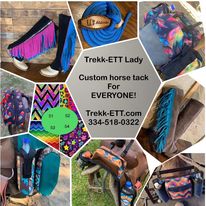Submitted by Miriam Rieck on
Living in Texas, I can honestly say there is no “perfect” riding terrain in my area, much less the entire state. We are either rocky as heck, have a high level of clay in the soil (think gumbo-like when wet), or deep sand. Perfect soil just does not exist naturally here… well, it might in someone’s garden, but they probably spent several years and lots of money and back-breaking effort to make it that way.
Some sand is actually not a bad thing; it provides depth and spring to an arena. Provided you have a solid base to back it, sand can be used as a top dressing. When your footing is sand, typically you set the depth to be about two to three inches deep for dressage, depending on the type of sand you’re using. If you are a reining competitor, you might go a little deeper. The idea is that if you watch a horse move across the arena, it shouldn’t leave inch-deep footprints and you should never, ever see the footing rising up over the horse’s hooves.
In an arena, footing is tricky. You want it to be deep enough to provide some traction, and deep and springy enough to provide a little cushioning, but you don’t ever want it to be too deep because then it becomes a threat to the horses’ tendons. Uneven footing is also dangerous, which is why a good arena will have a flat, well-compacted base and just the right amount and type of footing for the sort of riding that will be done there.
Which brings us to natural terrain riding or trail riding. Chances are you will not know what the terrain is going to be like UNLESS you have ridden that area in every season and every condition, then your knowledge of a set of trails becomes priceless.
One of the characteristics of an experienced endurance rider or competitive trail rider is not just expert knowledge of the terrain, but the ability to gauge the terrain and make decisions about the appropriate speed for the terrain. This ability is vital in determining how not just to win on speed, but to win on the condition of your horse and coming in with no injuries.
One of my favorite places to ride is a multi-thousand acre ranch located in Bellville, called 7IL. The trails are well-marked, varied enough, and are comprised of out-and-back multi loops. However, what makes it a challenging terrain to condition and train your horse on is that a lot of the trail is sand. Knowing the signs of firmly packed dirt or literally deep sand pits and being able to change your gaits from a steady, pacing trot to a slow walk makes it both a challenge and a good workout.
It takes time to build the equine athlete
So here are some tips on avoiding the dangers of injury and how to use sand as a conditioning tool for your horse. Conditioning horses is about gradual increases in various types of stressors so that you end up with an overall balanced and physically fit horse. Just like a human training in cardio and muscles, there is no overnight development. It takes time to build the equine athlete.
When a horse moves in sand two things happen. The heel of the horse’s hoof is narrower than the front and middle so the heel sinks and puts stress on the tendons. Since sand places a huge amount of stress on the tendons, riding in it should be done with care at first. When a horse is conditioned correctly using sand he will have tendons of steel. If you rush it, you can easily blow a tendon or tear a ligament and that requires months of healing.
Second, as the horse pushes with its hind legs, the sand absorbs much of the force and the horse compensates by pulling with its front legs. You need to be mindful of these movements when you start to condition your horse in sand.
Horses that are conditioned in sand usually have well-developed forearm and shoulder muscles. Most horses have relatively small forearm muscles and these muscles are incredibly large groups that need to be brought along slowly.
Watch the legs carefully for any sign of inflammation. When a horse moves in the sand, his fetlock joints move in ways they don’t normally move. This can cause inflammation; sandy conditions are harder on the joints than hard surfaces.
There are several types of injuries that commonly occur in horses ridden in deep sand.
Common deep sand related injuries in the horse
Wind puffs are soft, fluid-filled swellings toward the back of the fetlock joint, resulting from inflamed deep digital flexor tendon sheaths. The swellings occur where the digital flexor tendon sheath covers the two tendons that go around the back of the fetlock. In chronic cases, the sheath lining will remain thickened, and fluid levels will vary with the horse’s exercise levels. Once a horse has a problem with wind puffs, they are almost always a chronic condition.
Tendon and ligament strains and sprains involving the superficial digital flexor tendon, deep digital flexor tendon, accessory ligaments, and the suspensory ligament need to be watched for. Injuries can range from minor inflammation with no lameness to complete rupture of the tendon strap. Superficial flexor tendons run down the back of the foreleg, between the knee and foot. The deep digital flexor tendon runs under the superficial digital flexor tendon.
In the hind leg, they run between the hock and the foot and they cause your horse’s joints to flex when stimulated. Suspensory ligaments run behind the cannon bone over the fetlock joint to the pastern bones. They support the fetlock joint, which is your horse’s ankle.
In soft footing, your horse can also suffer pulled or strained hindquarter and forelimb/shoulder muscles. The muscles have to work extra hard because they lack traction. The foot will tend to slip at every step, adding more work to a leg already under stress.
Unfortunately, you might not notice this type of problem soon enough to prevent injury. You might remember later that your horse seemed to be sweating more or working harder than usual, but you didn’t relate that to the strained muscles or front/hind-leg weariness at the end of your ride.
My advice
So here is my final advice on riding your horse in deep sand (or really any type of terrain):
- Condition your horse
- Watch your horse and how it is feeling and acting
- Take a rest break if your horse is showing any kind of fatigue
- Watch other riders and their horses ahead of you. Whatever is happening to them is what you and your horse will go through
- Take it slow and steady on your training and conditioning. Remember an ounce of prevention is well worth the MONTHS of rest and repair that will be needed should any injury occur, and with these types of injuries you run the risk of permanent and chronic problems
- Shorten your ride or ease back on your conditioning if your horse is not coming along and check with your vet for hidden problems or issues
You can head off some problems by being prepared. Know your terrain/trail footing (ask other riders if this is new trail), know your horse, condition it for the various situations you might encounter, and be cautious in tricky terrain. Slow down, and don’t take chances. Happy Trails….










